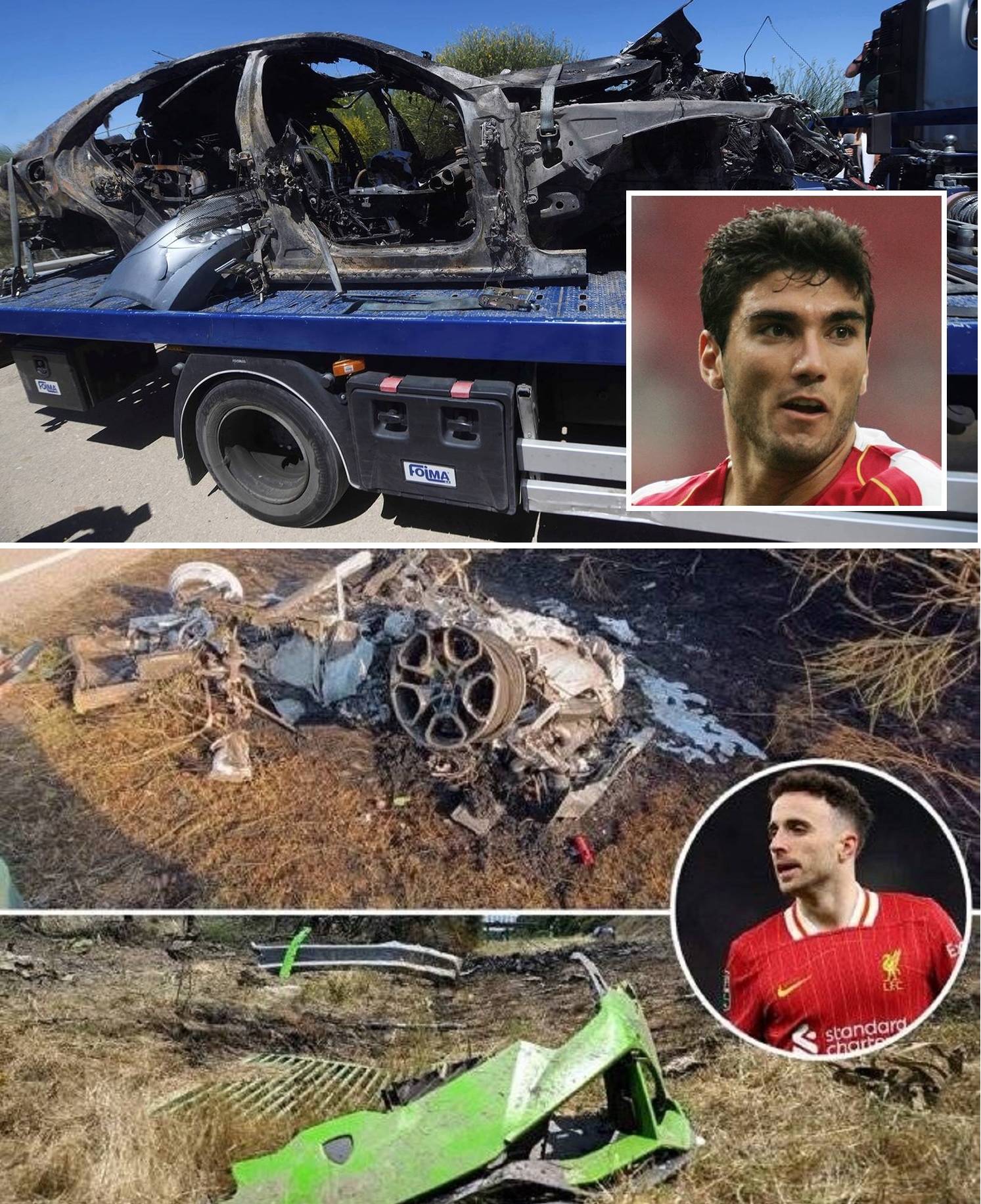Why Always Spain? The Tragic Pattern That Keeps Repeating 💔
In a heart-wrenching moment, Diogo Jota, like former footballer Jose Antonio Reyes, tragically lost his life in a car accident in Spain. The shocking detail: both suffered from a blown tyre while traveling at high speed.
Jota’s Lamborghini veered off the road, catching fire and claiming the lives of both him and his brother Andre. It’s an eerie parallel to Reyes’ death years ago under the same circumstances. Why does this seem to happen again and again in Spain?

The tragic accident that claimed the lives of Diogo Jota and his brother, Andre, on July 3rd in Spain has left the football world and fans worldwide in mourning. The details of the incident are hauntingly familiar, as this tragedy follows a similar sequence of events that led to the death of Jose Antonio Reyes, the former Arsenal and Sevilla FC star, who also lost his life in a car accident in Spain just years earlier. The eerie parallels between these two tragic events have raised uncomfortable questions about the country’s road safety, particularly for high-speed drivers. The most chilling coincidence of all? Both men died after suffering blown tyres while traveling at high speeds.
The Reyes Tragedy: A Blown Tyre at High Speed
The death of Jose Antonio Reyes on June 1, 2019, shocked the football world. The former Arsenal star was driving his Mercedes at high speed when a blown tyre caused him to lose control of the vehicle, resulting in a fatal crash. Reyes’ car overturned and crashed, and although emergency services were quick to respond, he was tragically pronounced dead at the scene.
Following the investigation into the accident, authorities confirmed that Reyes had been traveling at an excessive speed when the tyre blew. The subsequent loss of control led to the crash, a series of tragic events that would eventually rob the world of one of Spain’s most talented footballers. But the investigation also raised critical questions about the safety of roads in Spain and the possible underlying causes of accidents involving high-speed travel.
The case remained one of Spain’s most publicized car accidents, especially considering that Reyes was a beloved figure in Spanish football. His death sparked discussions about the dangers of high-speed driving, the importance of vehicle maintenance, and the vulnerability of tyres when subjected to intense pressure.
Diogo Jota’s Fatal Accident: The Same Tragic Scenario
Fast forward to July 3rd, 2025, and the world was once again rocked by a similar tragedy. Diogo Jota, the talented 28-year-old forward for Liverpool and the Portuguese national team, tragically lost his life in a high-speed crash in Spain. This time, Jota was driving a Lamborghini, which, like Reyes’ Mercedes, suffered a blown tyre while Jota was overtaking another vehicle on a high-speed road.
Witnesses reported that Jota’s car suddenly swerved off the road after the blowout, striking the central divider before bursting into flames. Despite the quick arrival of emergency responders and efforts to extinguish the fire, both Diogo and his brother Andre, who was traveling with him, tragically died at the scene. The loss of two lives in such a brutal and heartbreaking way has left fans and loved ones devastated, with many questioning the recurring circumstances of fatal accidents involving high-speed blowouts in Spain.
Why Always Spain? The Unsettling Pattern
The first question that many are asking following the death of Diogo Jota is: Why does this seem to keep happening in Spain? Both Reyes and Jota’s deaths shared chilling similarities, and both occurred in the same country, known for its well-maintained highways and modern infrastructure. Yet, the recurring theme of high-speed blowouts is difficult to ignore.
Is there something about driving in Spain that puts drivers at risk? Could it be that the temptation to drive at excessive speeds on straight highways, where the road conditions are typically good, leads to dangerous behaviour? Or is there a deeper issue at play? The connection between these two tragic incidents suggests that high-speed driving in Spain, especially in vehicles driven by individuals accustomed to fast-paced sports, may have led to these fatal accidents.
One disturbing trend is that both men were known for their confidence and speed on the pitch, but when behind the wheel, their vehicles were pushed to the limit in dangerous conditions. This connection between the aggressive style of play in sports and high-speed driving could be a factor that contributes to these types of accidents, particularly when blown tyres are involved.
The Dangers of High-Speed Driving: A Preventable Tragedy?
The mechanics behind a high-speed tyre blowout are simple yet dangerous. When a vehicle is traveling at high speeds, the pressure on its tyres increases, making them more susceptible to damage. Even a minor flaw or defect in the tyre can lead to a catastrophic failure, especially at speeds above 100 km/h (62 mph). The issue is compounded when drivers are overtaking or changing lanes at high speed, which leaves little room for error.
In both the case of Jose Antonio Reyes and Diogo Jota, the tyre blowout was the catalyst that caused the vehicles to lose control. While modern cars are equipped with safety features such as airbags, anti-lock braking systems (ABS), and stability control, there is little that can prevent a catastrophic crash if a tyre blows out while driving at high speed.
This highlights the importance of proper vehicle maintenance, especially for high-performance cars like the Lamborghini driven by Jota and the Mercedes driven by Reyes. Regular checks of tyres and other critical parts of a vehicle could help mitigate the risk of such fatal accidents. Drivers must also be aware of their own limits and the limits of their vehicles, especially when traveling at high speeds.
The Call for Stricter Road Safety Measures
The deaths of Reyes and Jota have sparked renewed calls for improved road safety measures in Spain. While the country is known for its well-maintained roads, more can be done to ensure that drivers adhere to speed limits and practice safe driving habits. There needs to be a stronger emphasis on educating drivers about the risks of high-speed driving and the importance of proper vehicle care.
The tragic deaths of these two athletes should serve as a wake-up call for not only Spain but for drivers worldwide. High-speed driving, while often exhilarating, is dangerous and can have devastating consequences.
In addition to speed limits and education, better technology could also play a role in preventing these types of accidents. Tyre monitoring systems and increased vehicle diagnostics could be the next step in improving car safety, especially for those driving high-performance vehicles.





